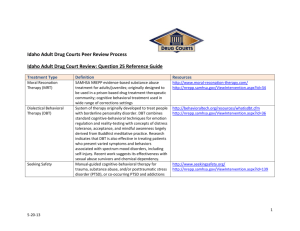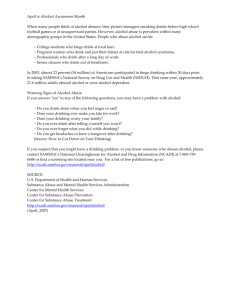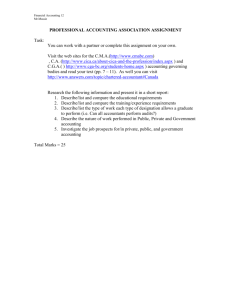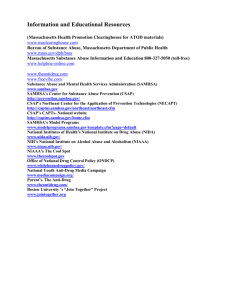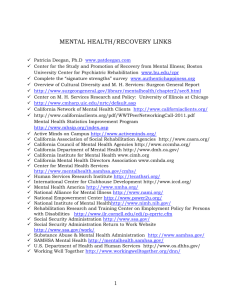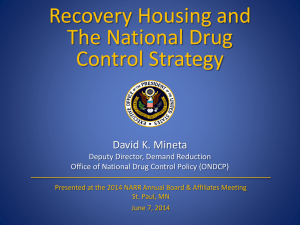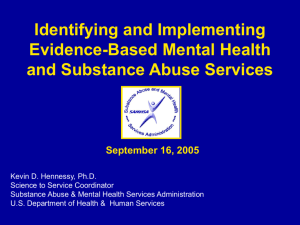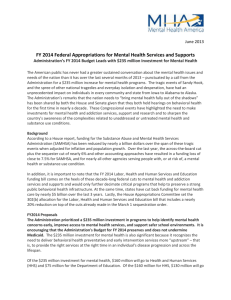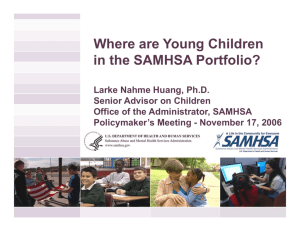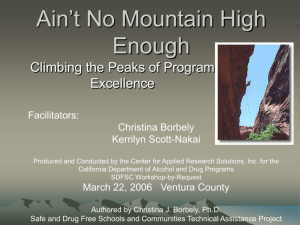Community Substance Abuse Interventions
advertisement
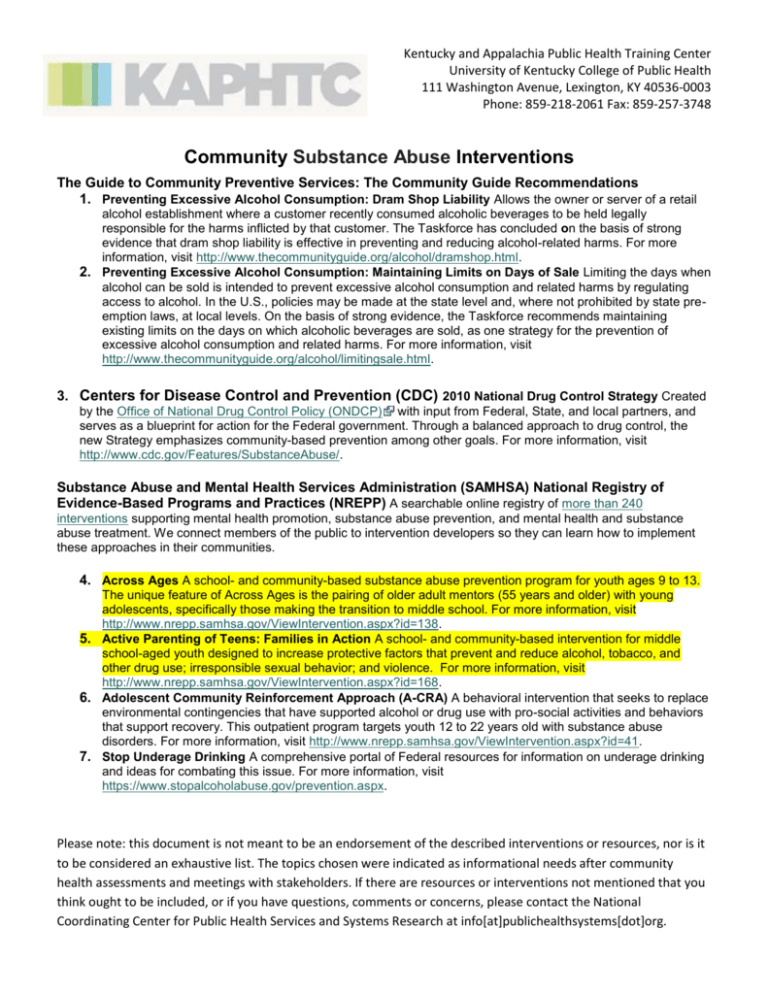
Kentucky and Appalachia Public Health Training Center University of Kentucky College of Public Health 111 Washington Avenue, Lexington, KY 40536-0003 Phone: 859-218-2061 Fax: 859-257-3748 Community Substance Abuse Interventions The Guide to Community Preventive Services: The Community Guide Recommendations 1. Preventing Excessive Alcohol Consumption: Dram Shop Liability Allows the owner or server of a retail alcohol establishment where a customer recently consumed alcoholic beverages to be held legally responsible for the harms inflicted by that customer. The Taskforce has concluded on the basis of strong evidence that dram shop liability is effective in preventing and reducing alcohol-related harms. For more information, visit http://www.thecommunityguide.org/alcohol/dramshop.html. 2. Preventing Excessive Alcohol Consumption: Maintaining Limits on Days of Sale Limiting the days when alcohol can be sold is intended to prevent excessive alcohol consumption and related harms by regulating access to alcohol. In the U.S., policies may be made at the state level and, where not prohibited by state preemption laws, at local levels. On the basis of strong evidence, the Taskforce recommends maintaining existing limits on the days on which alcoholic beverages are sold, as one strategy for the prevention of excessive alcohol consumption and related harms. For more information, visit http://www.thecommunityguide.org/alcohol/limitingsale.html. 3. Centers for Disease Control and Prevention (CDC) 2010 National Drug Control Strategy Created by the Office of National Drug Control Policy (ONDCP) with input from Federal, State, and local partners, and serves as a blueprint for action for the Federal government. Through a balanced approach to drug control, the new Strategy emphasizes community-based prevention among other goals. For more information, visit http://www.cdc.gov/Features/SubstanceAbuse/. Substance Abuse and Mental Health Services Administration (SAMHSA) National Registry of Evidence-Based Programs and Practices (NREPP) A searchable online registry of more than 240 interventions supporting mental health promotion, substance abuse prevention, and mental health and substance abuse treatment. We connect members of the public to intervention developers so they can learn how to implement these approaches in their communities. 4. Across Ages A school- and community-based substance abuse prevention program for youth ages 9 to 13. The unique feature of Across Ages is the pairing of older adult mentors (55 years and older) with young adolescents, specifically those making the transition to middle school. For more information, visit http://www.nrepp.samhsa.gov/ViewIntervention.aspx?id=138. 5. Active Parenting of Teens: Families in Action A school- and community-based intervention for middle school-aged youth designed to increase protective factors that prevent and reduce alcohol, tobacco, and other drug use; irresponsible sexual behavior; and violence. For more information, visit http://www.nrepp.samhsa.gov/ViewIntervention.aspx?id=168. 6. Adolescent Community Reinforcement Approach (A-CRA) A behavioral intervention that seeks to replace environmental contingencies that have supported alcohol or drug use with pro-social activities and behaviors that support recovery. This outpatient program targets youth 12 to 22 years old with substance abuse disorders. For more information, visit http://www.nrepp.samhsa.gov/ViewIntervention.aspx?id=41. 7. Stop Underage Drinking A comprehensive portal of Federal resources for information on underage drinking and ideas for combating this issue. For more information, visit https://www.stopalcoholabuse.gov/prevention.aspx. Please note: this document is not meant to be an endorsement of the described interventions or resources, nor is it to be considered an exhaustive list. The topics chosen were indicated as informational needs after community health assessments and meetings with stakeholders. If there are resources or interventions not mentioned that you think ought to be included, or if you have questions, comments or concerns, please contact the National Coordinating Center for Public Health Services and Systems Research at info[at]publichealthsystems[dot]org. Kentucky and Appalachia Public Health Training Center University of Kentucky College of Public Health 111 Washington Avenue, Lexington, KY 40536-0003 Phone: 859-218-2061 Fax: 859-257-3748 8. Big Brothers Big Sisters Mentoring Program Designed to help participating youth ages 6-18 ("Littles") reach their potential through supported matches with adult volunteer mentors ages 18 and older ("Bigs"). For more information, visit http://www.nrepp.samhsa.gov/ViewIntervention.aspx?id=227. 9. Border Binge-Drinking Reduction Program Provides a process for changing the social and community norms associated with underage and binge drinking that has proven effective at reducing alcohol-related trauma caused by young American's binge drinking across the U.S.-Mexican border. For more information, visit http://www.nrepp.samhsa.gov/ViewIntervention.aspx?id=115. 10. Communities Mobilizing for Change on Alcohol (CMCA) A community-organizing program designed to reduce teens' (13 to 20 years of age) access to alcohol by changing community policies and practices. For more information, visit http://www.nrepp.samhsa.gov/ViewIntervention.aspx?id=117. 11. Community Trials Intervention To Reduce High-Risk Drinking A multi-component, community-based program developed to alter the alcohol use patterns and related problems of people of all ages. For more information, visit http://www.nrepp.samhsa.gov/ViewIntervention.aspx?id=9. 12. Families and Schools Together (FAST) A multifamily group intervention designed to build relationships between families, schools, and communities to increase well-being among elementary school children. For more information, visit http://www.nrepp.samhsa.gov/ViewIntervention.aspx?id=30. 13. Multidimensional Treatment Foster Care (MTFC) A community-based intervention for adolescents (12-17 years of age) with severe and chronic delinquency and their families. For more information, visit http://www.nrepp.samhsa.gov/ViewIntervention.aspx?id=48. 14. Reality Tour A volunteer-driven substance abuse prevention program that is presented to parents and their children (ages 10-17) in a community setting over the course of one approximately 3-hour session. For more information, visit http://www.nrepp.samhsa.gov/ViewIntervention.aspx?id=192. 15. Reward & Reminder A population-level intervention targeting whole communities, counties, or states, that is designed to promote the community norm of not selling tobacco to minors. For more information, visit http://www.nrepp.samhsa.gov/ViewIntervention.aspx?id=98. 16. Focus on Prevention A guide developed to help a wide range of groups and communities move from concerns about substance abuse to proven and practical solutions. It is a starting point that offers brief, practical, and easy-to-read information that is useful in planning and delivering prevention strategies. To view the guide, visit http://store.samhsa.gov/shin/content/SMA10-4120/SMA10-4120.pdf. 17. Surgeon General’s Call to Action to Prevent and Reduce Underage Drinking: A Guide to Action for Communities. Gives community members the knowledge and tools to take action against underage drinking. It suggests ways to end underage drinking in communities across the country. For more information, visit http://www.surgeongeneral.gov/library/calls/underagedrinking/index.html. Canadian Best Practices Allows comparison of interventions. To access all of the interventions on their website, visit http://cbpp-pcpe.phac-aspc.gc.ca/. Click on “Best Practices” tab. 18. Communities That Care (CTC) A risk-and-protection-based system that enables local communities to engage in multi-level, multi-sectoral prevention planning and implement evidence-based programs for common youth behavior problems including substance abuse. For more information, visit http://66.240.150.14/intervention/25/view-eng.html. 19. Project Northland Project Northland is a multilevel intervention conducted in 24 school districts and adjacent communities in northeastern Minnesota beginning 1991. It involved students, peers, parents, and community in programs designed to delay the age at which adolescents begin drinking, reduce alcohol use among those already drinking, and limit the number of alcohol-related problems among young drinkers. For more information, visit http://66.240.150.14/intervention/253/view-eng.html. Please note: this document is not meant to be an endorsement of the described interventions or resources, nor is it to be considered an exhaustive list. The topics chosen were indicated as informational needs after community health assessments and meetings with stakeholders. If there are resources or interventions not mentioned that you think ought to be included, or if you have questions, comments or concerns, please contact the National Coordinating Center for Public Health Services and Systems Research at info[at]publichealthsystems[dot]org. Kentucky and Appalachia Public Health Training Center University of Kentucky College of Public Health 111 Washington Avenue, Lexington, KY 40536-0003 Phone: 859-218-2061 Fax: 859-257-3748 20. Strengthening Families for the Future A prevention program for families with children between the ages of seven and 11 who may be at risk for substance use problems, depression, violence, delinquency and school failure. Strengthening Families is effective because it involves the whole family. For more information, visit http://66.240.150.14/intervention/366/view-eng.html. 21. SNAP® Girls Connection (SNAP® GC) A specialized, family-focused program for young girls 6-11 years of age that involves the community level. In its 25 years of operation, the SNAP® model has become regarded as the most fully developed, longest sustained, empirically-based intervention for young children in conflict with the law under the age of 12. For more information, visit http://66.240.150.14/intervention/707/vieweng.html. 22. Transgender Resources and Neighborhood Space (TRANS) A collaborative project joining researchers, coordinators from local community-based organizations, health and social service providers, and community advocates in San Francisco that offers culturally and gender-sensitive health education to transgender women. For more information, visit http://66.240.150.14/intervention/683/view-eng.html. 23. Office of National Drug Policy Drug Free Communities Support Program (DFC) A Federal grant program that provides funding to community-based coalitions that organize to prevent youth substance use. Since the passage of the DFC Act in 1997, the DFC program has funded nearly 2,000 coalitions and currently mobilizes nearly 9,000 community volunteers across the country. Community coalitions can apply for these grants. For more information, visit http://www.whitehouse.gov/ondcp/drug-free-communities-support-program. 24. Trilogy Integrated Resources Network of Care Healthy Communities Health Indicators Web portal that tracks more than 100 community health indicators; provides a constantly updated community needs assessment; helps communities plan health interventions based on best practices from around the country and more. For more information, visit http://shasta.networkofcare.org/mh/about/press-release.aspx?id=310 or http://linn.ia.networkofcare.org/ph/. Please note: this document is not meant to be an endorsement of the described interventions or resources, nor is it to be considered an exhaustive list. The topics chosen were indicated as informational needs after community health assessments and meetings with stakeholders. If there are resources or interventions not mentioned that you think ought to be included, or if you have questions, comments or concerns, please contact the National Coordinating Center for Public Health Services and Systems Research at info[at]publichealthsystems[dot]org.
